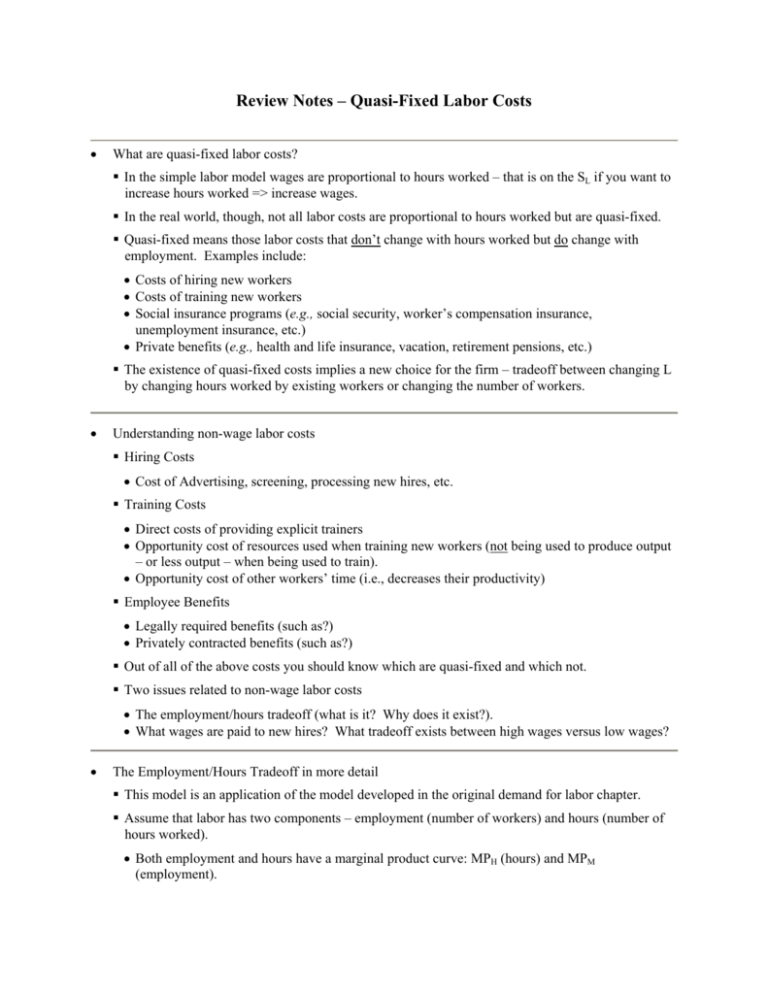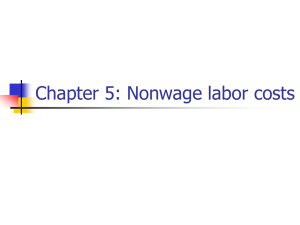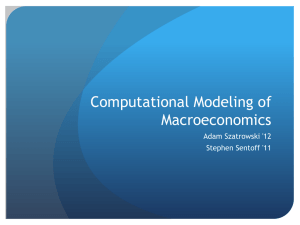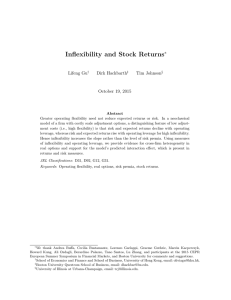Review Notes – Quasi
advertisement

Review Notes – Quasi-Fixed Labor Costs • What are quasi-fixed labor costs? In the simple labor model wages are proportional to hours worked – that is on the SL if you want to increase hours worked => increase wages. In the real world, though, not all labor costs are proportional to hours worked but are quasi-fixed. Quasi-fixed means those labor costs that don’t change with hours worked but do change with employment. Examples include: • Costs of hiring new workers • Costs of training new workers • Social insurance programs (e.g., social security, worker’s compensation insurance, unemployment insurance, etc.) • Private benefits (e.g., health and life insurance, vacation, retirement pensions, etc.) The existence of quasi-fixed costs implies a new choice for the firm – tradeoff between changing L by changing hours worked by existing workers or changing the number of workers. • Understanding non-wage labor costs Hiring Costs • Cost of Advertising, screening, processing new hires, etc. Training Costs • Direct costs of providing explicit trainers • Opportunity cost of resources used when training new workers (not being used to produce output – or less output – when being used to train). • Opportunity cost of other workers’ time (i.e., decreases their productivity) Employee Benefits • Legally required benefits (such as?) • Privately contracted benefits (such as?) Out of all of the above costs you should know which are quasi-fixed and which not. Two issues related to non-wage labor costs • The employment/hours tradeoff (what is it? Why does it exist?). • What wages are paid to new hires? What tradeoff exists between high wages versus low wages? • The Employment/Hours Tradeoff in more detail This model is an application of the model developed in the original demand for labor chapter. Assume that labor has two components – employment (number of workers) and hours (number of hours worked). • Both employment and hours have a marginal product curve: MPH (hours) and MPM (employment). • Both employment and hours have a marginal factor cost curve: MFCH and MFCM • The firm chooses H and M such that: MFCM/MPM = MFCH/MPH. • What are the implications of this result? If we increase overtime pay, then what happens to hours and employment? If we increase mandated benefits? If quasi-fixed costs increase? • Public Policy Discussion – we spent time in class discussing the impact of requiring double time for overtime pay – increasing required overtime pay and its expected impact on H and M. You should know the following as it relates to this public policy: (1) what has happened to quasi-fixed costs over time, (2) the direct impact of the proposed change (how does it differ from (1)?), (3) labor costs overall, (4) scale effect, (5) substitution effect, and (6) total compensation. • Part-time vs. Full-time employment. • Increased percentage of workers in part-time work. Why? • Supply side explanations. What are they? • Demand side explanations. Increase in quasi-fixed costs over time and part-time work avoids some of these costs (which ones?). • Should workers be fired at will or for cause? • How will firms respond to being required to fire for cause? • Make sure you understand why requiring for cause termination will reduce new job opportunities. • Labor Investments and Demand for Labor Taking into account time – investment in training in earlier years yields higher productivity in later years => who pays for and reaps the return for this investment? The firm must consider costs now and later as well as MP now and later. Assumptions of the model 1. 2. 3. 4. 5. 6. assume only 2 periods ignore hours vs. employment tradeoff and the cost of benefits (quasi-fixed costs) workers always work the entire period (only quit at the end) competitive markets, both labor and output markets Invest in training in the first period (0), reap return in the second period (1) The marginal products are given by MP0 < MP* < MP1 (where MP* = MP without training). Basically, while training MP decreases (MP0) but after trained then MP increases (MP1). 7. Wages in each period are W0 and W1 with W* equaling market wages without training. 8. An initial training cost, Z, is paid on a per worker basis. Because the model incorporates time => must also incorporate the concept of present value. Make sure you understand present value and future value. • Future value = Bi = Bo(1 + r)i where Bo= the initial investment in time period 0, r = the discount rate (0 < r < 1), and i equals the number of periods invested. • Present value = Bi/(1 + r)i. • Make sure you understand how these two work and what they mean. • The present value of MPL = PVP = MP0 + MP1/(1+r). • The present value of MFCL = PVE = W0 + Z + W1/(1+r). Firm decides to hire workers based on both present and future productivity and costs. That is they hire workers where PVP = PVE or: • MP0 + MP1/(1+r) = W0 + Z + W1/(1+r) • This is just a straightforward profit maximization problem with multi-period costs and returns (productivity). • Suppose Z=0 (no training costs) => one possible solution is to hire workers (L) where W0 = MP0 and W1 = MP1. (Why?) • What happens when Z>0? • Suppose that W0 + Z > MP0 => net loss to the firm => how does the firm respond in the second period? (Hint: net surplus) • Make sure you understand when the firm or the worker is investing in the training => who gets the return on the investment in each case. What happens if one period jobs are available at fixed wage = wage when not trained (W*)? This imposes another constraint. Workers will not take jobs unless W0 + W1/(1+r) ≥ W* + W*(1+r). • Why not? Recall our discussion of Table 5.3 p 149 in the book. Which wage stream represents W*? Under what conditions would workers/firms prefer each of the wage streams in Table 5.3? Would any wage stream not equal to option B work? Under what conditions? How can firms afford to pay a wage with a larger present value than option B? • General vs. Firm Specific Training Be able to define both types of training Our model implies that firms will not invest in general training. Why not? Our model implies that firms will invest in firm specific training. Why? • How does the firm structure wages during/after training so as to recoup their investment in training. See Figure 5.4 p. 152 for possibilities. • Three conditions exist in selecting wages 1. PVP = PVE or MP0 + MP1/(1+r) = W0 + Z + W1/(1+r) 2. W0 + W1/(1+r) ≥ W* + W*(1+r) 3. The firm must offer a post-training wage (W1) large enough to discourage quits => W1 must be greater than W* (why?) but < MP1 (why?). • What is the outcome if it becomes easier (less costly) for workers to quit? How about the reverse? • Make sure you understand the following points: • If W0 = MP0 and W1 = MP1 => workers pay for training and receive all the returns. Firms have no investment to protect and increase their firing of workers. • If W0 = W* and W1 = W* => firms pay for training and receive all the returns. Workers have no investment to protect and increase quits. • The model suggests that the result will be somewhere between these two extremes with both workers and firms investing and reaping a return on the firm-specific training. Why? • Make sure you know the empirical evidence. • Implications of the model 1. If Demand decreases (=> decreasing MP) it wouldn’t necessarily decrease employment. See Figure 5.6 p. 155. Employment would only decrease for general training but might not for firm specific training. Why? 2. In a recession, firms will tend to keep specifically trained workers (why?) => causes average productivity to fall. 3. In a recovery, firms will already have excess trained workers => can increase output without increasing employment as much => causes average productivity to rise. • Would Firms ever pay for General training? Recall that the model says no => talking about exceptions. 1. 2. 3. 4. If workers are contractually tied to the firm => can’t quit. If workers face high mobility costs => creating monopsony power => very costly to quit. If the firm is an actual monopsony => can’t quit. If general training can be used to help discover inherent worker abilities. This is the idea of credentials being used to screen applicants. This only works if the work with the credential (in this case some form of general training) has higher average productivity => the credential serves as a signal of productivity. What are the costs of this statistical discrimination? How about using an internal labor market for promotions?











